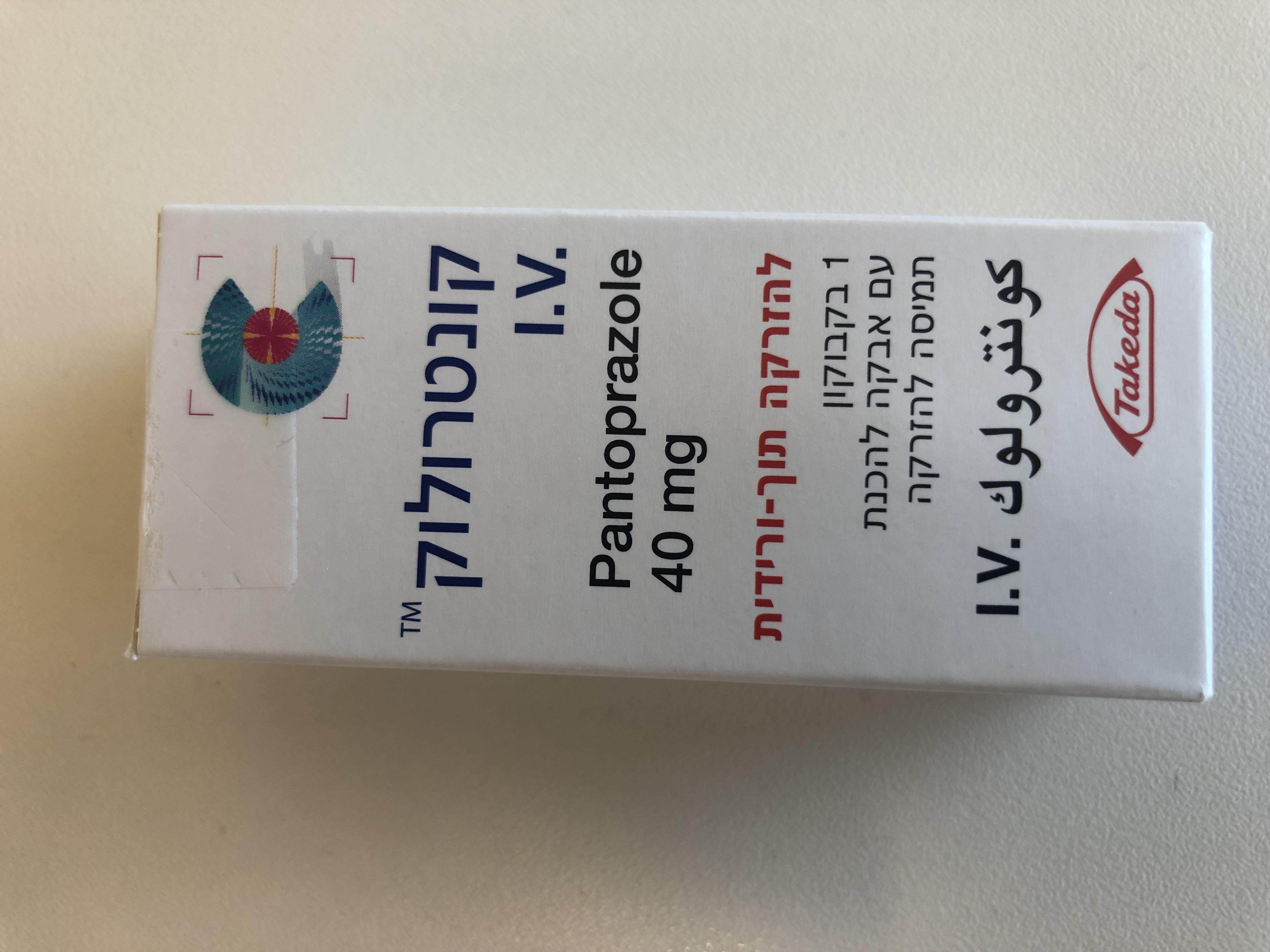Quest for the right Drug

קונטרולוק תוך ורידי CONTROLOC I.V. (PANTOPRAZOLE AS SODIUM)
תרופה במרשם
תרופה בסל
נרקוטיקה
ציטוטוקסיקה
צורת מתן:
תוך-ורידי : I.V
צורת מינון:
אבקה להכנת תמיסה לזריקה : POWDER FOR SOLUTION FOR INJECTION
עלון לרופא
מינוניםPosology התוויות
Indications תופעות לוואי
Adverse reactions התוויות נגד
Contraindications אינטראקציות
Interactions מינון יתר
Overdose הריון/הנקה
Pregnancy & Lactation אוכלוסיות מיוחדות
Special populations תכונות פרמקולוגיות
Pharmacological properties מידע רוקחי
Pharmaceutical particulars אזהרת שימוש
Special Warning עלון לרופא
Physicians Leaflet
Special Warning : אזהרת שימוש
4.4 Special warnings and precautions for use Gastric malignancy Symptomatic response to pantoprazole may mask the symptoms of gastric malignancy and may delay diagnosis. In the presence of any alarm symptom (e.g. significant unintentional weight loss, recurrent vomiting, dysphagia, haematemesis, anaemia or melaena) and when gastric ulcer is suspected or present, malignancy should be excluded. Further investigation is to be considered if symptoms persist despite adequate treatment. Hepatic impairment In patients with severe liver impairment, the liver enzymes should be monitored during therapy. In the case of a rise of the liver enzymes, the treatment should be discontinued (see section 4.2). Co-administration with HIV protease inhibitors Co-administration of pantoprazole is not recommended with HIV protease inhibitors for which absorption is dependent on acidic intragastric pH such as atazanavir, due to significant reduction in their bioavailability (see section 4.5). Gastrointestinal infections caused by bacteria Treatment with Controloc® I.V. may lead to a slightly increased risk of gastrointestinal infections caused by bacteria such as Salmonella and Campylobacter or C. difficile. Controloc® I.V. contains Sodium This medicinal product contains less than 1 mmol sodium (23 mg) per vial, that is to say essentially ‘sodium-free’. Hypomagnesaemia Severe hypomagnesaemia has been rarely reported in patients treated with proton pump inhibitors (PPIs) like pantoprazole for at least three months, and in most cases for a year. Serious manifestations of hypomagnesaemia such as fatigue, tetany, delirium, convulsions, dizziness and ventricular arrhythmia can occur but they may begin insidiously and be overlooked. Hypomagnesaemia may lead to hypocalcaemia and/or hypokalaemia (see section 4.8). In most affected patients, hypomagnesaemia (and hypomagnesaemia associated hypocalcaemia and/or hypokalaemia) improved after magnesium replacement and discontinuation of the PPI. For patients expected to be on prolonged treatment or who take PPIs with digoxin or medicinal products that may cause hypomagnesaemia (e.g., diuretics), health care professionals should consider measuring magnesium levels before starting PPI treatment and periodically during treatment. Bone fractures Proton pump inhibitors, especially if used in high doses and over long durations (>1 year), may modestly increase the risk of hip, wrist and spine fracture, predominantly in the elderly or in the presence of other recognised risk factors. Observational studies suggest that proton pump inhibitors may increase the overall risk of fracture by 10–40%. Some of this increase may be due to other risk factors. Patients at risk of osteoporosis should receive care according to current clinical guidelines and they should have an adequate intake of vitamin D and calcium. Severe cutaneous adverse reactions (SCARs) Severe cutaneous adverse reactions (SCARs) including erythema multiforme, Stevens-Johnson syndrome (SJS), toxic epidermal necrolysis (TEN) and drug reaction with eosinophilia and systemic symptoms (DRESS) which can be life-threatening or fatal, have been reported in association with pantoprazole with frequency not known (see section 4.8). At the time of prescription, patients should be advised of the signs and symptoms and monitored closely for skin reactions. If signs and symptoms suggestive of these reactions appear, pantoprazole should be withdrawn immediately and an alternative treatment considered. Subacute cutaneous lupus erythematosus (SCLE) Proton pump inhibitors are associated with very infrequent cases of SCLE. If lesions occur, especially in sun exposed areas of the skin, and if accompanied by arthralgia, the patient should seek medical help promptly and the healthcare professional should consider stopping Controloc® I.V. SCLE after previous treatment with a proton pump inhibitor may increase the risk of SCLE with other proton pump inhibitors. Interference with laboratory tests Increased Chromogranin A (CgA) level may interfere with investigations for neuroendocrine tumours. To avoid this interference, Controloc® I.V. treatment should be stopped for at least 5 days before CgA measurements (see section 5.1). If CgA and gastrin levels have not returned to reference range after initial measurement, measurements should be repeated 14 days after cessation of proton pump inhibitor treatment.
Effects on Driving

שימוש לפי פנקס קופ''ח כללית 1994
לא צוין
תאריך הכללה מקורי בסל
לא צוין
הגבלות
לא צוין
מידע נוסף
